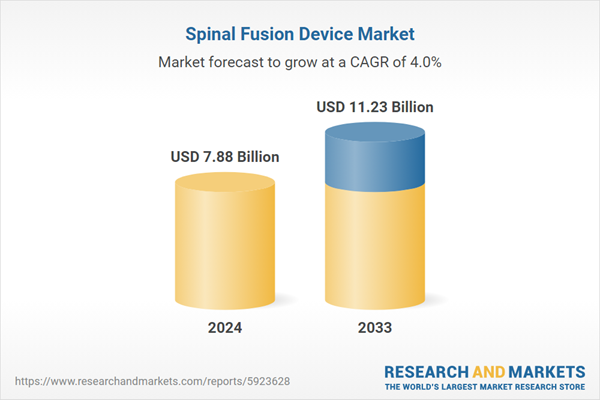Spinal fusion device market growth
The worldwide Spinal fusion device market growth is expected to surpass $11 billion during the year 2033. This is because of the growing number of spinal diseases. Sedentary lifestyle, obesity, and ageing population lead to the increased rates of spine disorder. The most frequent patients are made up of degenerative disc disease, herniated disc, and stenosis spinal. These kinds of pathologies are usually treated surgically so that pain may be halted, and there will be regained mobility.
Spinal fusion devices play a significant role in stabilizing the spine. They help fuse two or more vertebrae and reduce movement as well as future degeneration. Technology is refining these devices to be more effective and easier to implant. Less invasive procedures are gaining popularity, reducing recovery time and improving outcomes for patients. Surgeons currently have 3D-printed implants and bioresorbable materials available to them. These technologies enhance rates of fusion success and reduce complications.
North America leads the spinal fusion device market currently.
The region is blessed with high health expenditure, excellent medical centers, and strong demand for new therapies. Europe is second, and increasing investments in spinal surgery are fueling growth. The Asia-Pacific region is increasingly becoming a significant growth market. Increasing health consciousness and better access to care are fueling demand in China and India.
The competition is fierce in the market, and the leaders are investing heavily in research and development. The industry leaders include Medtronic, Stryker, and Zimmer Biomet. They are more interested in creating new implants, robotic surgical instruments, and biologics for spinal fusion. Strategic acquisitions and alliances are aiding them in increasing market share. They aim to enhance surgical performance and improve patient comfort.
Although there is a bright future in the market
There are a number of challenges. Spinal fusion surgeries are expensive and thus limit accessibility to most patients. Highly restrictive regulatory procedures also slow down new product approval. Some patients and doctors prefer artificial disc replacement and regenerative medicine as treatment alternatives. But more government and insurance coverage can ease these challenges.
Spinal fusion device market growth will continue to expand in the years ahead. Spine care treatments are increasingly being demanded worldwide. With the progression of technology, patients should expect safer and more effective treatment. With the ongoing development of research, spinal fusion devices will perform better. It will be able to provide improved outcomes to patients suffering from disabling spinal disorders.



